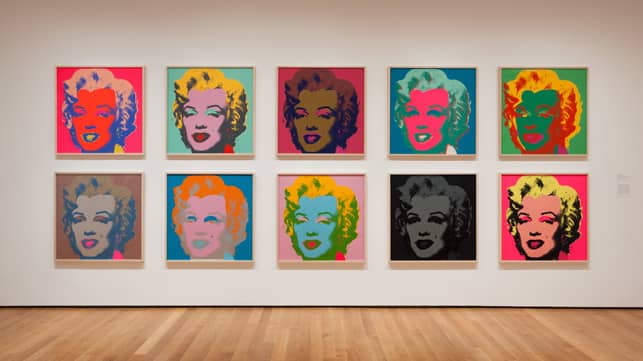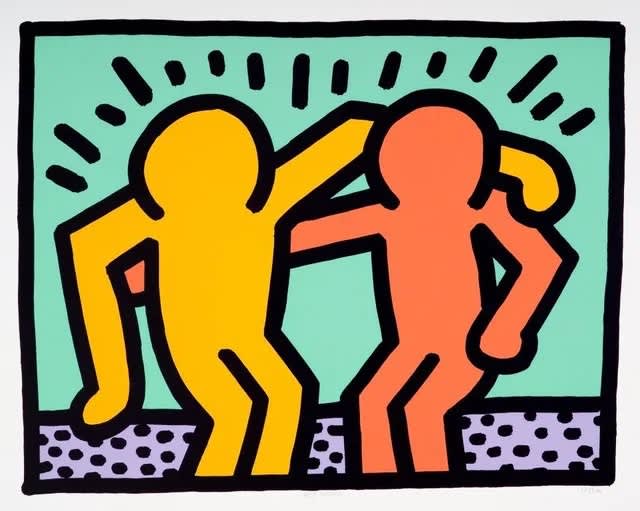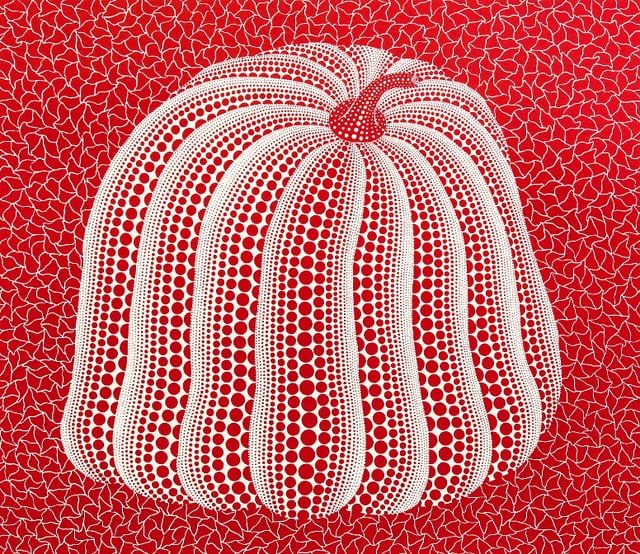Artists Do the Same Thing Over and Over Again
Pattern and Repetition in Gimmicky Fine art
Modern and Gimmicky Artists apply repetition not simply to improve on an initial version, but as the footing of their art, creating rhythm and regularity inside their work.
The years following World State of war Two saw the triumph of the mass production of consumer goods: the long assembly lines of identical cars or washing machines, the food shop windows full of lookalike cornflake packets inspiring Pop artists like Andy Warhol to borrow the materials, techniques, and imagery of mass production for their art.
Andy Warhol
It's impossible not to associate Andy Warhol with the apotheosis of repetition. Working with silkscreens and media imagery, information technology was easy for the pop artist to recreate his images en masse and, in doing then, to gloat mass culture - from his iconic prints of Marilyn Monroe, Elvis Presley and Elizabeth Taylor to his reproduction of everyday products, such every bit Campbell'due south soup cans, Coca-Cola bottles, boxes of Brillo Pads and dollar bills.

Andy Warhol, Marilyn Monroe. 1967, MOMA
Repetition was central to his work; he would create grids of identical images which were presented much in a similar format to a book of stamps, the but variety lying in his choice of color. Simply if Warhol was using repetition to comment on mass production in a consumerist world, he preferred non to say - instead, simply claiming that, 'I like things to be exactly the aforementioned over and over again.'
Keith Haring
Keith Haring was obsessed past semiotics, the study of signs and symbols. Symbolism and Egyptian hieroglyphics were an important source of inspiration for the artist's visual language and announced throughout his oeuvre. "I am intrigued with the shapes people choose equally their symbols to create language." Haring said. "In that location is inside all forms a basic construction, an indication of the entire object with a minimum of lines, that becomes a symbol. This is mutual to all languages, all people, all times."

Keith Haring, Best Buddies, 1990, Screenprint
In the alphabet of picture-words he developed, each recurring epitome carries its own fix of meanings. From his 'radiant babe,' a likely symbol of the future and perfection, to his barking, biting and dancing dogs which developed into an iconic image associated with the artist to the reoccurrence of UFOs and crucifixes.
Despite the violent imagery that is rampant in Haring's work, his primal message was one of devout humanism and honey. Take his recurring embrace, which is oftentimes between two genderless and race-less figures, who are glowing as they hold each other.
Yayoi Kusama
For Yayoi Kusama, artwork and mental health are intrinsically linked, with her apply of repetition acting as a treatment for her anxiety and depression. Working beyond multiple mediums - from functioning art to painting, collage to sculpture - the artist uses repetition equally a class of therapy to calm and focus the mind.
Her repeat signature polka dot patterns, psychedelic colours and organic forms are always-present in her art with the artist known to work in 50- to sixty-hour stretches, covering sheets of paper with miniscule, repetitive marks to not only fed her love of art, but as well help her cope with the stress-induced hallucinations she's experienced from a young age.
Pumpkins are another recurring motif within her oeuvre in a collection of works celebrating the bailiwick's "generous unpretentiousness." Rooted in her babyhood, Kusama'southward love of pumpkins has significantly shaped her exercise for over 70 years. Whether cropping up equally detailed drawings, public sculptures, or immersive installations, Kusama's stylised interpretations of the humble squash have get some of her about well-known works-and are among gimmicky art's most iconic masterpieces.

Yayoi Kusama, Ruby-red Pumpkin, 1994, Screenprint
"I honey pumpkins," the artist said in 2015, "because of their humorous form, warm feeling, and a human being-like quality."
Unlike polka dots and flowers-whose hallucinatory forms frightened the budding artist-Kusama plant comfort in pumpkins, noting that she was "enchanted by their charming and winsome form" as early as her outset encounter. "The start fourth dimension I ever saw a pumpkin was when I was in elementary school and went with my grandfather to visit a big seed-harvesting basis," Kusama recalls in Infinity Internet, her autobiography. "And there information technology was: a pumpkin the size of a human's head . . . It immediately began speaking to me in a most animated manner."
Damien Hirst
Damien Hirst began his 'Controlled Substances' series, more than ordinarily known as spot paintings, in 1988. Based on a simple grid format, the paintings feature circular 'spots' of coloured paint, each representing a chemical, lined up at regular intervals, with the spaces betwixt them ever the same distance as their bore, on a white background.
While the early works are manus drawn and painted by the artist, with visible marks from the compass with which he used to make the dots, many critics were quick to label Damien Hirst every bit some sort of corporate art car, afterwards the creative person created multiple studios across England to churn out huge numbers of these spot paintings. In 2012 there were over 1500 spot paintings which he would then sell for vast sums but this allegation didn't much bother the artist, particularly when the pieces were already centred on the concept of repetition and pattern.

Damien Hirst, Ethidium Bromide Aqueous Solution, 2005
Every bit he says of Andy Warhol, the original male monarch of repetition, 'Warhol's dandy. You lot can't argue with that. And visually peachy. It'south like shooting fish in a barrel, inexpensive, unproblematic. He certainly doesn't over-complicate things. I think that'due south good. And in terms of consumerism and all that sort of stuff, art has been in a constant battle for hundreds of years with every other kind of image-making.' And, Hirst might add, the studios of old masters were full of assistants, helping to create the frequently similar religious works ordered by patrons.
Lefty Out There
Lefty Out There is a street creative person by nature, so it'due south no surprise to find repetition in the American creative person'south piece of work; graffiti artists frequently create a simplistic and repetitive style that's unique to them - their own personal branding if you like. By creating intuitive, repeated shapes, Lefty Out There achieves the rare feat of working in contradictions. His piece of work is both bold and intricate, organic only uniform.

Lefty Out At that place, Sanguine Amnis Album, 2019
A simple marking makes up a considerably more complex whole. Lefty Out There's signature calling cards are what he calls 'the squiggles' - the lines he employs to create intricate and repetitive pattern piece of work for the fashion, art and blueprint globe. "I just got progressively more than and more obsessed with the lines. I tin can walk up to something and the first thing my brain tells me to do is a hook squiggle. It'south but natural." Post-obit a spontaneous desire, Lefty'south pattern making makes the centre linger and yearn for interpretation - likened to jail cell structures and organisms, they telephone call for the audience to pay attention to things that they take for granted.
Source: https://maddoxgallery.com/news/61-the-art-of-repetition-pattern-and-repetition-in-contemporary-art/
0 Response to "Artists Do the Same Thing Over and Over Again"
Post a Comment